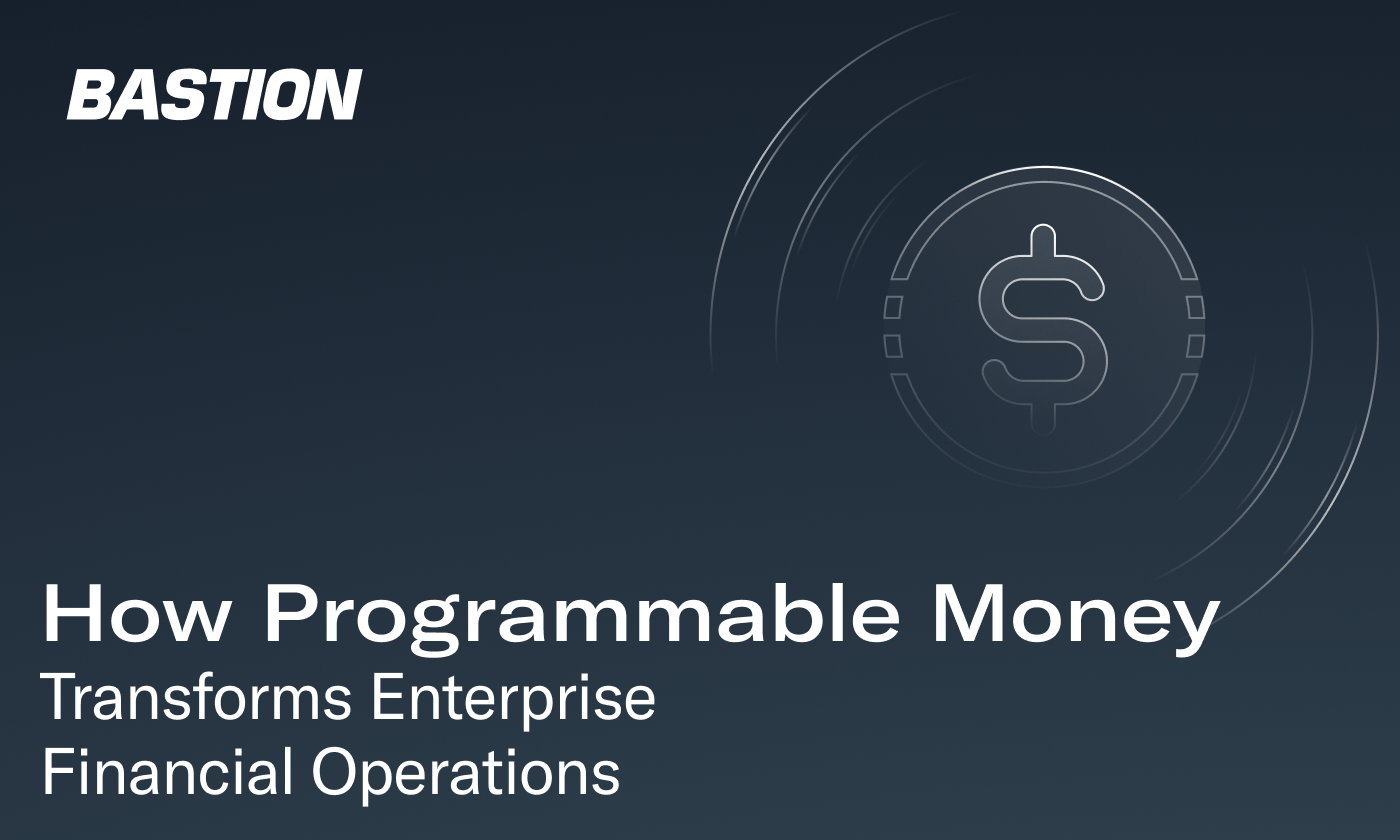
Moving money is harder than it should be for large enterprises. Transfers between accounts, subsidiaries, and vendors are slowed down by fragmented systems and manual approvals. Fees pile up, capital sits idle, and yield is lost. In 2025, a joint study between Oxford Economics and FISGlobal found that inefficient financial operations (“financial disharmony”) can cost each enterprise a whopping $100 million annually. 51% of these organizations said they face the most friction when money is actually moving.
This is where programmable money comes in. Programmable money refers to digital assets with built-in rules that govern how funds move. Once conditions are met, the rules trigger transactions automatically. That means faster settlement, better liquidity, and tighter control over capital.
Think of it like a highway. Traditional money movement is filled with detours and toll booths. Programmable money removes the stops and lets funds travel directly to where they need to go.
Why It’s Important to Explore the Concept of Programmable Money
Switching business rails to programmable money requires a major shift, but most teams can see the benefits and want to learn more. A 2025 paper, Programmable Money: Societal Perceptions and Responses in the Digital Age, published on SSRN, showed this clearly. In its survey:
- 51.3% of people are neutral, which encompasses those who want more information
- 35.14% have somewhat positive thoughts
- 8.11% have very positive thoughts
- 5.41% have somewhat negative thoughts
Programmable money uses technology called smart contracts. Think of them as digital agreements written into code. When two parties, like a company and a vendor, make an agreement on the blockchain, no bank or middleman is needed. Once the agreed conditions are met, the smart contract automatically carries out the transaction and records it permanently on the blockchain. This makes payments faster and cheaper because there are no bank fees.
Compliance concerns are also being addressed. Clearer rules have been provided through the GENIUS Act in the United States, Markets in Crypto-Assets Regulation (MiCA) in the twenty-seven state European Union, Hong Kong’s Stablecoin Ordinance, Singapore’s Payment Services Act, the UAE's CBUAE Payment Token Services Regulation, among others.
The Hidden Cost of Manual Financial Operations
Most enterprises still run critical payments and treasury functions through outdated systems. It means more work for finance teams, slower transactions, and higher costs across the board. These systems were built for slower and more local economies. Today, they expose deeper structural limits: siloed banking networks, poor interoperability, and heavy reliance on manual steps for routing and compliance. The result is higher fees, slower payments, and constant inefficiencies that overwork finance teams and cost enterprises millions each year in fees, tools, and staff.
Every delay adds up. A late payment, a manual approval, or a stuck transfer compounds the problem. Enterprises try to fix bottlenecks by adding new tools, but those fixes create new complications. They optimize again, yet the system was never built for today’s needs, so the cycle continues.
Programmable money also reduces the risks of human error. Banks have lost millions by sending funds to the wrong accounts because of mistyped entries. Coded transactions remove that risk because they don’t require manual input.
That’s why it’s important to leverage next generation tools: programmable money. Enterprises can set the rules for how funds move, having them automatically executed. This shift transforms reactive financial management to proactive, automated systems, changing how enterprises manage liquidity, settle payments, and optimize capital.
Transforming Global Payment Systems
Here are five major inefficiencies along with the problems they cause and specifics on solving them:
- making global payments
- cash sitting idle
- manual treasury operations
- paying for transactions
- complex payment logic
The challenge: cross-border payments
In traditional financial systems, global manufacturers or businesses have to set up bank accounts in every local market they pay suppliers or partners in, or partner with a financial institution to do it. If they’re lucky, they can work with top-tier banks to simplify the process. If not, they’ll need multiple relationships with partners across the globe. Accounts set up in different countries rarely connect directly and often use different currencies. If your treasury team is saddled with managing these relationships, they’ll have to route payments through a chain of regional banks, each operating on its own schedule with its own costs and compliance processes.
Corporations often need to pre-fund local accounts in other countries with more cash than is actually required. This traps capital and increases exposure to foreign exchange risk. In India, for instance, enterprises frequently pre-fund INR accounts because sending money into the country can be complex and slow.
When a payment needs to cross two or three of these banking “hops,” each one adds its own handling fees (like toll booths on highways) with enterprises needing to address exchange rates, which causes delays. Payment rails batch transactions and close at set cut-off times, which can push settlements over weekends or holidays. Once completed, treasury teams spend time reconciling across banks that don’t share real-time data.
Soft costs also exist with fragmented bank accounts. Account departments need person hours to close and reconcile books and treasury teams need to administer additional portals, save more bank statements, and cash position more accounts.
What started as a single supplier payment can quickly become a multi-leg journey that might take days, cross multiple currencies, and erode the original amount by several percentage points. Multiply this by hundreds or thousands of payments per month, and the costs compound quickly.
This complexity is the result of legacy systems that simply weren’t built for the intricacies of today’s business operations. Siloed institutions have become toll booths on every segment of the route rather than the efficiency-engines that they were thirty years ago.
The solution: programmable money
With programmable money, funds move across regions and blockchains, making money movement efficient and cost-effective. Settlement rules can include optimal FX execution, corridor selection, and timing, triggered automatically and, even better, compliance checks can be designed to run in parallel with the transfer instead of halting it for review. All parties see the transaction in real time, too, removing reconciliation delays and allowing executives to continue to make well informed, real-time decisions.
The challenge: idle cash
For day-to-day operations, enterprises spread reserves across different accounts, like operating, payroll, collections, and accounts payable. These balances often earn minimal returns. When companies want to move funds into higher-yield instruments or accounts, they coordinate manually with banking partners. The process is clunky: mismatched timing, internal approvals, and fragmented systems cause missed yield opportunities. As a result, enterprises not only earn less on their capital but may also need to borrow or raise cash for working capital while their own money sits idle.
The solution: programmable money
The same rules that slow enterprises down today can be built into programmable money, but in a way that executes instantly and removes manual work. When balances exceed predetermined thresholds, liquidity triggers can automatically transfer funds to yield-bearing accounts. If operational needs change, your enterprise can instantly recall funds. This yield-optimization logic runs continuously without treasury intervention.
The challenge: manual treasury operations
As noted, moving money between subsidiaries, divisions, or vendors often requires manual approval, especially for highly regulated companies or when managing rules in different countries.
Transactions pass through multiple systems and teams before completion, more like stop-and-go traffic than a direct route. Compliance and policy checks are handled manually instead of in real time, which can add hours or even days to the process.
The result is predictable: treasury becomes a bottleneck. Payments are delayed, projects stall, flexibility is limited, and teams grow frustrated.
The solution: programmable money
Instead of waiting on treasury teams to review every transfer, programmable money allows the system to handle routine approvals automatically. Internal funding rules can execute automatically when account balances change with approvals embedded in transaction logic. Transfers can therefore meet parameters without extra review cycles and, once rules are met, settlement occurs immediately, freeing the treasury from routine approvals.
The challenge: paying for transaction data
Enterprises pay not only to move money but also to see where that money goes. When transactions run through external networks like payment processors, the transaction is spread across banking partners who charge additional fees as they monetize the flow of funds. Each transaction creates data, which remains with the network. For large enterprises with many business units, accessing it often means paying again for information about their own operations.
Beyond the costs, enterprises face challenges with the data itself. When data across regions isn't standardized, real-time analysis is more difficult and companies possess limited visibility into their own cash positions and flows. This lack of transparency limits insights into customer and vendor behaviors and restricts real-time decision making, causing missed opportunities for optimal money movement choices.
The solution: programmable money
With smart contracts, every transaction generates a real-time record with immediately accessible data that’s delivered in a standard format. Enterprises can use that data to analyze flows across their ecosystem without waiting for bank reports.
The challenge: complex payment logic
When payments are tied to milestones, revenue sharing, or multi-party settlements, they require manual monitoring. Operations teams end up tracking contract terms, confirming events, and triggering payments in a process prone to errors and delays that can damage vendor and partner relationships. This means that time is lost on administrative payment management with an increased risk of disputes or missed obligations.
The solution: programmable money
Event-based triggers can release funds automatically once conditions are met with smart contract logic, ensuring compliance with contract terms without manual follow-up. Then, when conditions are satisfied, transactions settle instantly.
Envisioning the Possibilities: Automated Financial Operations
Programmable money provides exactly that: programmability, automated to follow a set of rules and allowing anyone who participates in a transaction to benefit.
- Treasury departments appreciate real-time liquidity optimization, automatic funding between entities, and continuous yield capture.
- Vendors and partners profit from payments triggered by delivery confirmations’ or contract milestones’ faster speeds and reduced costs.
- Customers can receive instant refunds, even with international transactions, and real-time loyalty rewards.
- Integrated fraud detection benefits all parties.
You can incorporate the use of programmable cash without building a stack. Leveraging crypto doesn’t mean that you need to be a crypto company. Programmable money can integrate with existing ERP and treasury systems with compliance logic built into the transaction layer. Security and regulatory requirements can be managed by specialized infrastructure providers.
Enterprises using programmed money gain faster payments, lower costs, and better use of capital. The benefits increase as more processes are automated.
Your money should work as hard as your team. Let it do the heavy lifting for your business by outfitting it with the best tools, just like you would for your best departments.
